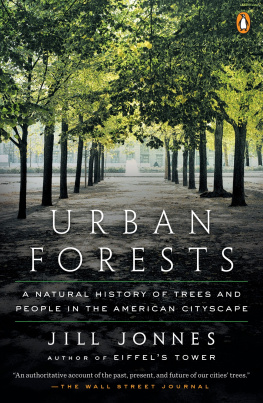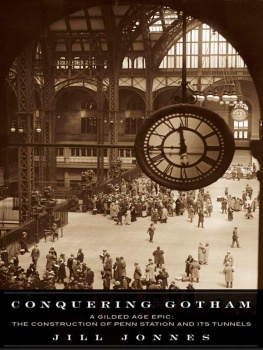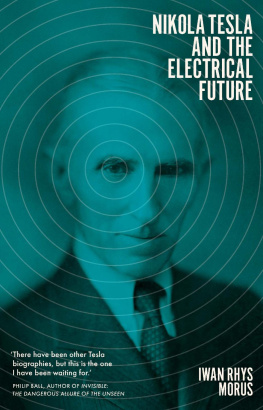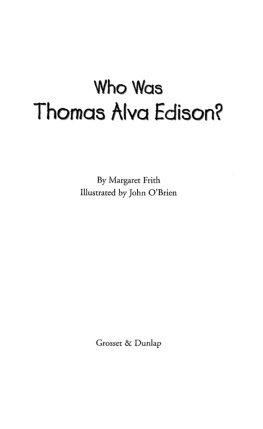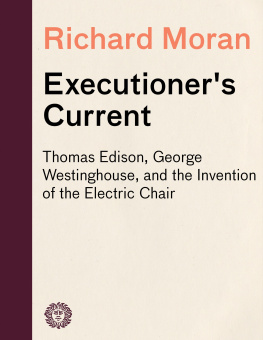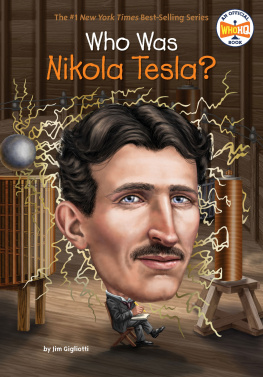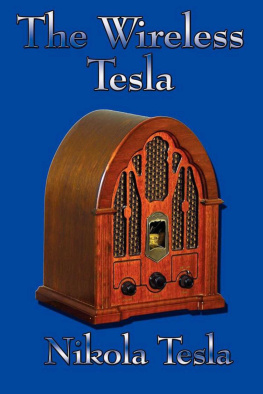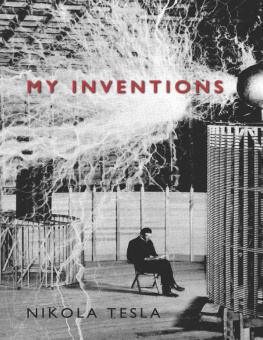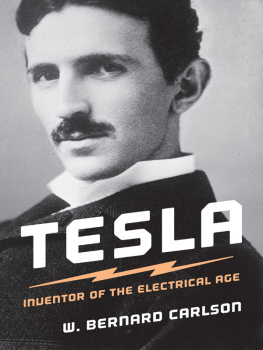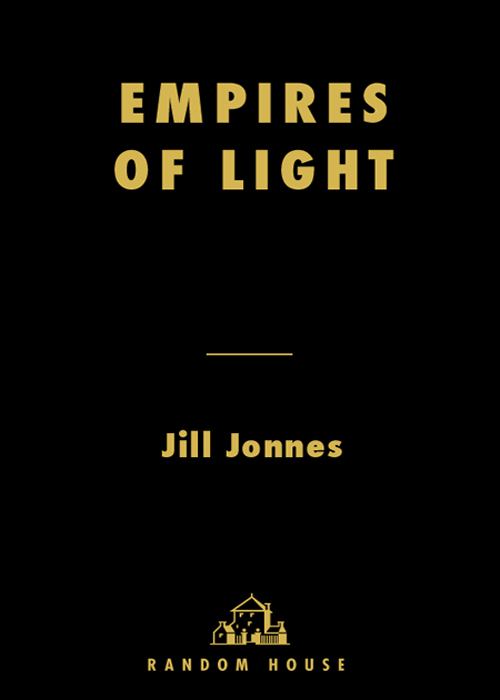Contents
Morgans House Was Lighted Up Last Night |
Endeavor to Make It Useful |
Thomas Edison: The Wizard of Menlo Park |
Nikola Tesla: Our Parisian |
George Westinghouse: He Is Ubiquitous |
Edison Declares War |
Constant Danger from Sudden Death |
The Horrible Experiment |
1891: Fear Everywhere of Worse to Come |
The Worlds Fair: The Electricians Ideal City |
Niagara Power: What a Fall of Bright-Green Water! |
Yoked to the Cataract! |
Afterward |
For my husband, Christopher Ross
Great are the powers of electricity. It makes millionaires. It paints devils tails in the air and floats placidly in the waters of the earth. It hides in the air. It creeps into every living thing. Last night it nestled in the sherry. It lurked in the pale Rhine wine. It hid in the claret and sparkled in the champagne. It trembled in the sorbet electrique. Small wonder that the taste was thrilled and the man who sipped was electrified. Energy begets energy.
Buffalo Morning Express,
January 13, 1897,
describing the banquet
celebrating the citys first
electricity from the
Niagara Falls Power Company
List of Scientific Diagrams
EMPIRES of LIGHT
EMPIRES of LIGHT
Introduction
Great, indeed, is the power of electricity. And in the final decades of the nineteenth century, three titans of Americas Gilded Age were among the Promethean few who dreamed of the possibilities hidden in this ethereal force of natureits awesome power visible only in the wild rumble and slash of electrical storms. Each titan was determined to master the mysterious fluid. Each vied to construct an empire of light and energy on a new and monumental scale; each envisioned radiant enterprises that would straddle the globe, illuminating the inky night and easing forever the burden of brute labor. Thomas Alva Edison was the best known of these dreamers in 1879. The nations greatest inventor, Edison was creator of the incandescent light bulb and mastermind of the worlds first incandescent light network. Then there was Nikola Tesla, the elegant, highly eccentric electrical wizard who revolutionized the generation and delivery of electricity. Tesla was the Serbian immigrant dreamer who foresaw using the vibrating waves of the earth itself to generate unlimited power and communications. The final member of this trio was George Westinghouse, the charismatic Pittsburgh inventor and tough corporate entrepreneur. He built up company after company, an industrial idealist who imagined a world powered by cheap and plentiful electricity. All his working life, he strove heart and soul to create that electrified world.
This is also the story of the nascent years of the electric power industry and the rise of a new technology that completely transformed society, a tale told largely through these three visionary figures, their triumphs, their blunders, their caustic feuds. As each struggled to make real his electrical dreams and dominate the subtle and vivifying current, the stage was set for one of the most unusual and vicious battles in American corporate history, the War of the Electric Currents. This war pitted Thomas Edison and his tried-and-true technology of DC (direct current) against Westinghouse and Teslas new and experimental AC (alternating current). It is the archetypal corporate struggle, a modern industrial epic where American business titans battled to dominate and control a world-changing technology, to create whole new Empires of Light. In a time of nineteenth-century Darwinian harshness, these new technologies drove the relentless growth of large and complex corporations, the economic basis for a century of astonishing societal and material change. The rise of unchecked capitalism and large corporations, in turn, forced the nation to confront its entire form of governance. Empires of Light is a story that resonates strongly in our times.
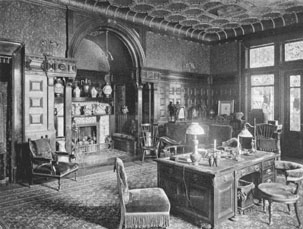
Library of the J. Pierpont Morgan house
CHAPTER 1
Morgans House Was Lighted Up Last Night
I n the late spring of 1882, Thomas Alva Edison, world famous as the folksy genius who had invented the improved telegraph and telephone, the amazing talking phonograph, and the incandescent light bulb, would shamble in occasionally to the hushed, formal suites of Drexel, Morgan & Company at 23 Wall Street, an imposing white marble Renaissance palace of mammon. There in a glass-walled back office, J. Pierpont Morgan presided at an oversize rolltop desk. The autocratic senior partner wore a bankers black suit, starched snowy shirt, wing collar, and fine gray silk ascot. His expensive, ever-present Havana cigar made the air smoky, redolent of privilege and power. Morgans investment firm was partially bankrolling Edisons fevered building of Americas first incandescent electric lighting system in the crowded commercial blocks of lower Manhattan. When Edison visited Drexel, Morgan, the clean-shaven, still boyish inventor loved to disparage the offices gaslight globes as burning a vile poison. But soon the gaslight would be gone, preempted by Edisons beloved clean electric light.
Edison, thirty-five, was already a celebrated figure in the downtown streets, recognizable in his signature slouch-brim hat or battered stovepipe, shabby shirt, bright neckerchief, and frayed black Prince Albert coat. He and his crews were logging dusty eighteen-hour shifts as they pushed to finish the far-behind-schedule Pearl Street Station generating plant and install (only at night) fourteen miles of just-below-the-street electrical conduits. All morning and afternoon pedestrians ebbed and flowed through the financial neighborhood, dark-suited men sporting shiny top hats or black bowlers, clutching their canes. Bank messengers, with bags filled with coin, greenbacks, bills of exchange, bonds and stocks, hurry along, wrote one contemporary of hustling-bustling Wall Street, keeping a firm grip upon their bags and eying each person they pass warily, office boys, telegraph boys with yellow envelopes containing messages from all quarters of the globe, dart here and there through the throng. These acolytes of the high-toned, handsome financial district shared the jammed nearby streets with horse-drawn trolleys, heavy delivery wagons, dog-drawn rag carts, noisy oyster sellers, and small boys hawking any one of the citys dozens of newspapers. Everywhere, with the weather warming up, the citys streets reeked of horse piss and dung left daily by the 150,000 horses pulling the citys trams, trucks, Broadway stages, and fancy rigs. At night, when Edison most liked to work, he could be found with his Irish crews laying trenches somewhere near Pearl Street, already dirty with grease and tar, or tinkering with the six jumbo dynamos installed up on the reinforced second floor.
That late spring and summer, Edison had occasion to confer with J. Pierpont on another small but important job. In his office, Morgan cultivated a renowned ferocity: the gruff, impatient bark, the famed glare that challenged visitors of any rank to intrude. Other wealthy men in this most hirsute of eras flaunted complex and flamboyant beards and mustachios, but the forty-five-year-old Morgan sported only a plain, trimmed mustache. J. Pierpont Morgan had been raised an old money gentleman, conservative and stern in manner and habits. But the America of the 1880s was changing rapidly, daring men and women to dream bold dreams, to grasp for great ventures and great wealth. Just a few blocks south, the Roeblings magnificent East River Bridge was nearing completion after thirteen arduous years, a soaring engineering marvel of suspension, floating across the shimmering New York waters. Nearby, the elevated railroads with their small belching steam engines chugged stolidly along, high above the chaos and stench of Manhattans tangled traffic, astounding visitors with their efficient moving of tens of thousands of workers as they snaked north between tenements and offices and then out to the far bucolic reaches of the city. The miracle of the great Atlantic cable flashed telegrams across the coldest depths of the ocean. Where once letters from Pierponts father in the London office took weeks to arrive, now telegrams pulsed through in mere minutes. The railroads had become mighty, creating new cities where there had been only marshland or prairie. In just the past year, they had laid an astounding ten thousand miles of track. The 1880 census showed fifty million Americans. Morgan, unlike many of his old money peers, relished this new temper of the times, admired men like Edison who were bold, ambitious, hardworking, confident.


